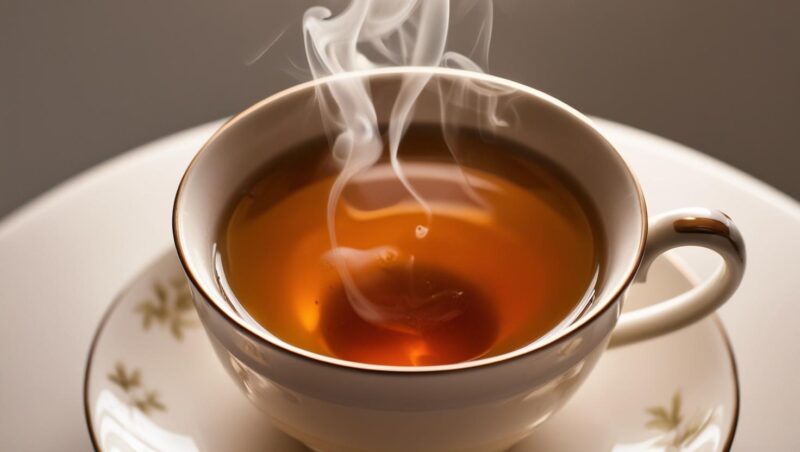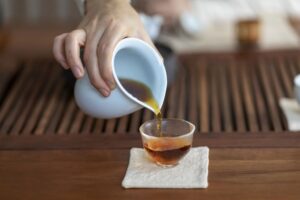If you’ve ever savored a steaming cup of Earl Grey tea, you might have wondered how much caffeine is in it. This beloved tea, known for its unique flavor profile due to the addition of bergamot oil, not only tantalizes your taste buds but also provides intriguing health benefits.
In your quest for healthy caffeine sources, understanding the caffeine content is essential, especially if you’re monitoring your energy levels or looking to optimize your daily routine.
As we dive deeper into the nuances of Earl Grey, we’ll explore its ingredients, rich history, and how its caffeine levels stack up against other traditional teas and beverages.
So, grab your favorite teacup, and let’s get started on this aromatic journey!
The Basics of Earl Grey Tea

This flavorful beverage is a distinctive type of black tea infused with bergamot oil, derived from the rind of the bergamot orange.
What Is Earl Grey Tea?
Traditionally, the base of this beverage is black tea, known for its robust flavor and moderate caffeine content, making it a popular choice for those seeking a refreshing yet energizing drink.
Earl Grey tea facts reveal that an 8-ounce cup typically contains around 50 milligrams of caffeine, offering a suitable option for those conscious about their daily caffeine intake.
The Ingredients of Earl Grey Tea
The classic recipe consists of black tea leaves combined with bergamot oil. This formulation not only shapes the flavor but also contributes to the tea’s numerous health benefits.
Modern variations of Earl Grey may include additional flavorings, leading to diverse tea blends and caffeine levels, each with unique characteristics.
The infusion of bergamot is rich in antioxidants, enhancing the tea nutrition aspect, providing health advantages that can range from improved heart health to elevated mood.
Origins and History
The origins of Earl Grey tea are surrounded by intriguing historical facts about Earl Grey tea. Named after British Prime Minister Charles Grey, the 2nd Earl Grey, its history dates back to the 19th century.
One popular theory suggests that a Chinese merchant gifted the original blend to Grey, which soon garnered a reputation among the British elite, reflecting sophistication and class.
Over the years, the term ‘Earl Grey’ has evolved, now broadly used to describe any tea blend featuring bergamot, indicative of its lasting appeal in various cultures.
How Much Caffeine Is in Earl Grey Tea
Understanding the caffeine content in Earl Grey tea can enhance your experience as a tea drinker.
The caffeine levels in tea, particularly Earl Grey, can vary significantly based on several factors. Here, we’ll explore the average caffeine content, the elements that affect it, and how Earl Grey tea compares to other beverages.
Caffeine Content Overview
The caffeine content in Earl Grey tea typically ranges from 40 to 120 milligrams per eight-ounce cup.
This wide range arises from various factors including the brewing time, tea brand, and preparation methods. Generally, classic Earl Grey’s, made with black tea, have a caffeine level that falls between 50 and 90 milligrams.
For those considering alternatives, decaffeinated Earl Grey teas contain about 5 to 10 milligrams, while Earl Grey Rooibos offers a caffeine-free experience without sacrificing flavor.
Factors Affecting Caffeine Levels

Here are some important factors to consider:
- Type of Tea: The base tea, whether black, green, or herbal, significantly impacts the overall caffeine content. Black tea variants like Assam and Keemun provide higher levels, while green tea versions average around 35 milligrams.
- Water Temperature: Hotter water can extract more caffeine. To optimize your tea caffeine content, use an appropriate temperature during steeping.
- Steeping Time: The recommended steep time for optimal caffeine extraction is about three to four minutes. Longer steeping yields higher caffeine concentrations.
- Amount of Tea Leaves: Using more leaves generally increases caffeine content, offering more flexibility for your desired caffeine intake.
Comparison with Other Teas and Beverages
When comparing Earl Grey tea caffeine with other beverages, it finds its place comfortably within the medium range. Here’s a quick look at how it stacks up:
Earl Grey tea offers a moderate caffeine option that stands out in its flavor profile while providing some energy lift.

Conclusion
Earl Grey tea stands out not only for its unique flavor profile but also for its moderate caffeine content, making it a favorite amongst tea lovers.
With caffeine levels ranging from 40 to 120 milligrams per 8-ounce cup, understanding these variations helps you tailor your tea-drinking experience to meet your energy needs.
Whether you’re looking for a boost in caffeine for energy or simply enjoying a soothing cup, these Earl Grey tea insights can guide you in choosing the right blend.
Exploring variations such as Decaffeinated Earl Grey or Green Earl Grey allows you to diversify your intake while being mindful of your caffeine consumption.
Incorporating a range of Earl Grey options, from herbal blends like Rooibos to stronger variations like Extra Strong Earl Grey, ensures there’s something for everyone.
Ultimately, this beloved tea continues to enhance the tea-drinking experience while keeping caffeine intake in check.




